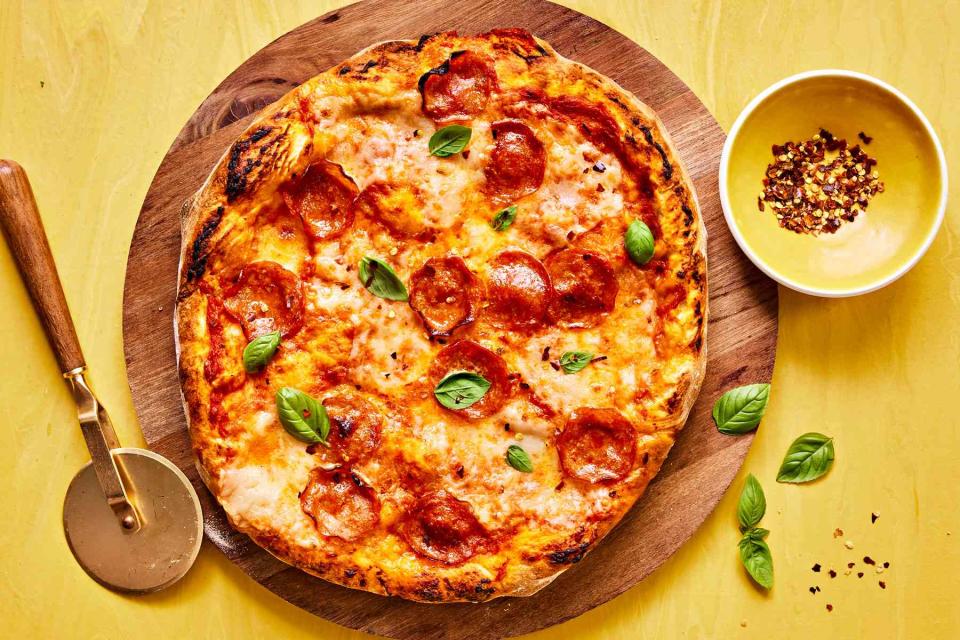How to Make the Best Homemade Pizza—According to the Pros
Whether you need a quick dinner or a fun idea for hosting family and friends, the answer is probably (definitely!) a homemade pie.

Antonis Achilleos
The next time you need a quick dinner idea or a fun party theme, turn to homemade pizza. It's easy, you already have all the gear you'll need, and you can make it your own with a wide variety of toppings. To make sure the crust turns out crispy and avoid any hint of sogginess, we ask the pros for their top tips for making delicious homemade pizza. From buying dough at your favorite local pizza place, to setting your oven to the right temp (hint: it's hotter than you think!), here are the pro-approved tricks for excellent homemade pizza.
:
How to Make a Crispy Pizza Crust
The pizza police will not come after you for using store-bought dough. Well, they might...to give you an award for brilliance! The fresh stuff in the refrigerated section and the frozen balls in the freezer aisle are very good and super-convenient. Your favorite pizzeria may also sell dough—just ask.
Whatever kind you use, let the dough (thawed if frozen) sit at room temperature for up to an hour before you stretch it into shape, to give the gluten time to relax. If the dough resists stretching, let it sit for 10 more minutes, then come back to it. “A well-relaxed dough will stretch easily—key for making a great pie," says Martin Philip, baking ambassador at King Arthur Baking Company.
For an interactive dinner party that’s easy on the cook (a.k.a. you), prep the dough, set out toppings, and let guests build their own personal pizzas. You can bake four at a time, and all you need to round out the meal is a big green salad. Phew!
The Sauce
Sauce can be anything, well, saucy. Jarred marinara, pesto, crème fraîche, ricotta, or even a slick of olive oil will do the trick. Or take a cue from Mark and Jenny Bello. The owners of Pizza School NYC make a no-cook tomato sauce with a 28-ounce can of crushed or pureed tomatoes. “If the tomatoes are a no-salt-added variety, stir in a teaspoon of salt. Then taste the tomatoes, and if they seem too acidic, add a teaspoon of sugar,” Mark says. Add one tablespoon of dried oregano and one teaspoon of garlic powder. Spread a thin layer of the sauce on the crust, and refrigerate or freeze the rest for future pies.
The Cheese
Obviously, mozzarella is classic. Deb Perelman, creator of the blog Smitten Kitchen, likes the low-moisture variety, as opposed to fresh. “Why add more moisture to a pie I’m trying to keep from getting soggy?” she asks. The Bellos recommend a whole-milk, not part-skim, version of low-moisture mozzarella. “It melts better at home-oven temperatures without browning too much and getting tough,” Jenny says.
If you opt for fresh mozzarella, make sure it isn’t brand-spanking-new. When the Bellos get theirs fresh, Mark says, “we drain any liquid, wrap it in plastic, and let it rest in the fridge for a day or more to let the milk settle into the cheese to help avert soggy pizzas.”
Any melty cheese works on pizza, depending on the flavor profile you’re building. Try Gruyère with mushrooms and leeks, or Monterey Jack with spicy shredded pork or barbecue chicken. A post-cooking sprinkle of Parmesan or pecorino Romano will add another layer of salty goodness.

Antonis Achilleos
Add Delicious Toppings
On most pizzas, less is more, and this applies to both the quantity and variety of toppings, according to the Bellos. “Great pizza is all about restraint and balance. It helps keep the crust from being soggy or gummy,” Mark says. You can always add more toppings once the pie comes out of the oven—especially anything you don’t want to cook, like arugula, oil-packed tuna, and large shavings of hard cheese (a few of Philip’s favorites).
Because most pizzas bake quickly, precook anything that isn’t safe to eat raw, like Italian sausage, and anything that won’t be maximally delicious after just 10 to 15 minutes in the oven, like most hard veggies. Hearty leafy greens, like kale and broccoli rabe, are also best precooked.
The Pizza-Making Gear
If you don’t have special pizza equipment, you can bake the pie on a baking sheet. Sprinkle cornmeal onto the sheet to prevent sticking, stretch the dough, place it on the sheet, top it, and slide it into a preheated oven. The crust probably won’t be very crisp in the middle, but your pie will be solid. For a great pizza, a baking surface that gets really hot—a pizza stone or steel—is clutch, Philip says. “A preheated surface will get the bottom crispy and encourage that wonderful crust puff around the edges.”
If you use a stone, you’ll also need a peel (a kind of paddle) to get the pizza onto it. Both Philip and the Bellos prefer wood peels to metal, because the dough tends to stick less. Either way, sprinkle the peel with semolina flour or cornmeal for easier transfer of pizza to stone. A stone and peel should run you less than $100 total, but if you aren’t ready to commit, the Bellos recommend a pizza screen. “At $10, it’s an inexpensive upgrade from a baking sheet,” Jenny says. “Brush the screen very lightly with oil and gently lay your stretched crust on top. Dress your pizza and place it directly on the oven rack. The open heat and air-flow from below make for a crispy crust.”
The Oven
In a word, you want it blazing. Crank that baby up to 500°F if your appliance allows. In an oven that hot, your pizza should cook in less than 15 minutes. As for rack placement, start by using the middle position and see if your pizza is cooking faster on the top or bottom, the Bellos advise. “If it’s uneven, move the rack up or down a rung for the next pie, and observe,” Mark says. “You’ll quickly intuit the thermodynamics of your oven.” (Science!) You can also take your pizza-making outside. The popular Ooni and other outdoor tabletop pizza ovens can reach temps up to 950°F—closer to what you’d find in a serious pizzeria—and pies may cook in as little as a minute or two.
Foolproof Homemade Pizza
For a nearly impossible-to-mess-up home pizza experience, do like Perelman and embrace the grandma pie: a thick-crust, rectangular pizza made on a baking sheet—no stone, peel, or ripping-hot oven required. “It’s just easier in almost every way. You don’t have to worry about overtopping it, and since it has a relatively long bake time, up to 30 minutes, the crust cooks all the way through and gets a really deep brown,” she says. Plus, unlike with most pizzas, leftovers reheat amazingly well. Perelman’s recipe for grandma pizza in her new cookbook, Smitten Kitchen Keepers, makes two baking sheets’ worth. “We’ll eat one for dinner, and I’ll pop the other sheet in the fridge to reheat for dinner later in the week.”
For more Real Simple news, make sure to sign up for our newsletter!
Read the original article on Real Simple.

